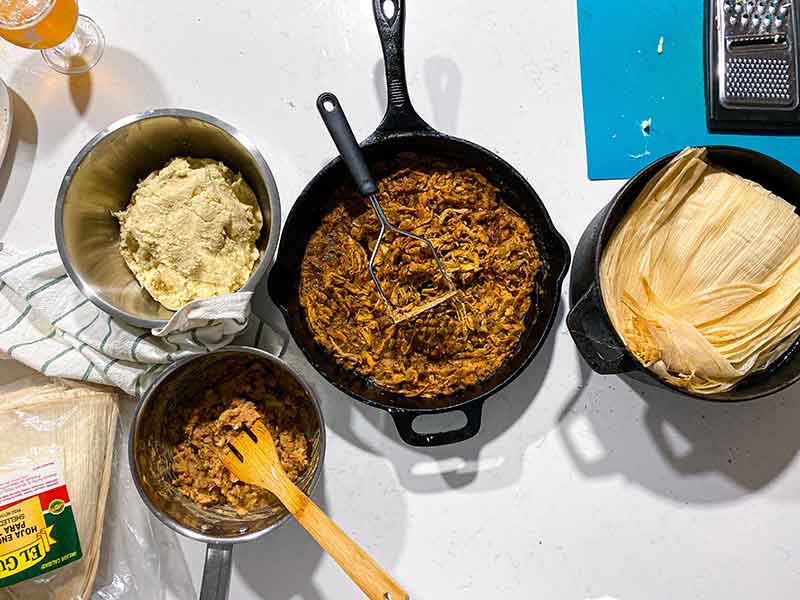A Culinary Tradition Weaving Through Holiday Celebrations
Jose Mier is an Hispanic name, of course and with a Mexican heritage (and living in Latino-heavy Sun Valley, CA) part of our new year celebrations invariably involves tamales.
Tamales, a time-honored and cherished culinary tradition, hold a special place in the hearts and homes of many communities around the world. Originating in Mesoamerica thousands of years ago, these delicious parcels of masa (corn dough) filled with various savory or sweet ingredients have become a symbol of celebration, especially during holidays. This essay will explore the rich history of tamales, their cultural significance, and the integral role they play in holiday festivities.
Historical Roots of Tamales
The origins of tamales can be traced back to ancient Mesoamerican civilizations, including the Aztecs and Mayans. The word “tamal” comes from the Nahuatl language, spoken by the Aztecs, and it means “wrapped food.” Tamales were not only a culinary delight but also had ritualistic and symbolic importance in these ancient cultures.
The basic components of tamales – masa and filling – have remained relatively consistent over the centuries, with regional variations reflecting the diverse culinary landscapes of the Americas. Masa, made from nixtamalized corn (corn soaked in an alkaline solution), is the backbone of tamales, providing the unique texture and flavor that distinguishes them from other dishes.
Cultural Significance of Tamales
Tamales have transcended their historical roots to become a staple in the cuisines of various Latin American countries, each adding its own twist to the traditional recipe. The process of making tamales has also become a communal activity, often bringing families and communities together. The act of preparing tamales has been passed down through generations, becoming a cherished tradition that fosters a sense of connection and continuity.
In addition to their role as a communal food, tamales hold cultural and symbolic significance. They are often associated with celebrations, rites of passage, and religious ceremonies. The act of sharing tamales during special occasions creates a bond among individuals and strengthens cultural identity. The versatility of tamales, with both sweet and savory variations, allows them to be enjoyed in various contexts, from breakfast to dinner and everything in between.
Tamales in Holiday Celebrations
The festive season brings a heightened appreciation for traditional foods, and tamales stand out as a beloved centerpiece in holiday celebrations across Latin America and beyond. Their popularity during holidays can be attributed to several factors, including their rich history, versatility, and the communal nature of their preparation.

- Christmas Celebrations:
In many Latin American countries, tamales are an integral part of Christmas traditions. Families gather in the weeks leading up to Christmas to engage in the labor-intensive but rewarding process of making tamales. This communal preparation not only eases the workload but also reinforces family bonds and shared cultural practices.
Christmas tamales often feature unique fillings, such as pork or chicken seasoned with achiote, a spice derived from the annatto seed. In Mexico, for example, the Christmas Eve feast, known as “Nochebuena,” is incomplete without a plate of tamales. The aroma of steaming tamales fills households, signaling the arrival of the holiday season.
- Las Posadas:
In Mexico, the holiday tradition of Las Posadas involves a reenactment of Mary and Joseph’s journey to Bethlehem in search of shelter. During the nine nights leading up to Christmas Eve, communities come together to celebrate with processions, caroling, and, of course, food. Tamales are a staple during Las Posadas, symbolizing the sharing of sustenance and hospitality – key themes in the Christmas story.
- New Year’s Celebrations:
As the calendar turns, tamales continue to play a significant role in New Year’s celebrations. Families may prepare a fresh batch of tamales to welcome the new year with a feast. The act of sharing tamales during this time is believed to bring good fortune and unity to the family.
- Dia de la Candelaria (Candlemas):
Following Christmas, many Latin American communities celebrate Dia de la Candelaria, also known as Candlemas, on February 2nd. This day marks the end of the Christmas season and is often associated with the presentation of the infant Jesus at the temple. Tamales are a customary dish during Dia de la Candelaria, symbolizing the offerings made by Mary and Joseph on this occasion.
- Other Celebrations:
While tamales are prominently featured during Christmas and New Year’s, their presence extends to other holidays and special occasions. From birthdays to weddings, tamales add a touch of tradition and flavor to a variety of celebrations.
Conclusion
In conclusion, tamales have woven themselves into the fabric of holiday celebrations, becoming a symbol of joy, togetherness, and cultural heritage. Their journey from ancient Mesoamerican rituals to modern holiday feasts highlights the enduring appeal and adaptability of this culinary tradition. Tamales not only satisfy the palate but also serve as a reminder of the rich history and diverse cultures that contribute to the tapestry of our global community. So, as you savor the warmth and flavor of a tamale during your next holiday celebration, remember that you are partaking in a timeless tradition that transcends borders and connects generations.